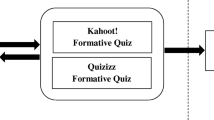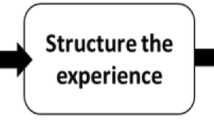Abstract
An evolution of teaching and learning experience in higher education witnesses many techniques being introduced towards student-centered learning. One of the most popular techniques is game-based learning or known as gamification to enrich students experience in classroom. However, the awareness among educators is lacking and the anxiety whether gamification benefits the learning process is prominent. This paper is written to provide an insight into gamification and its ability to instill students’ engagement. The questionnaire set and model to evaluate the students’ engagement following gamification during teaching and learning process are also studied and presented. Literature review method is used to investigate the relevant subjects related to the gamification for higher education and ways to evaluate its effectiveness. This study showed that there exist several studies on students’ engagement and gamification which are deemed useful to promote students’ engagement. Besides, the study discovered that improved Technology Acceptance Model (TAM) is a good measure to investigate its effectiveness.
Similar content being viewed by others
Keywords
1 Introduction
One of the main challenges confronted by educators today is to engage students during teaching and learning process in the classroom. Students’ preceding learning (readiness), enthusiasm for learning, and the way the input is introduced to them are some of the factors that influence their ability to learn [1]. Diverse learning styles among the students also contribute to the way they engage in the activities conducted by the educators. Sustaining the students’ interest and participation is a struggle that leaves the educator in a quandary. This is because students’ involvement plays an important factor in their achievement and performance [2] measured during either the formative or summative assessment. Mohd et al. [3] discovered that active students have more tendency to perform well as they retained more knowledge during learning activities.
Several studies have been done referring to gamification as a technique to improve the students’ engagement [4,5,6]. Technological developments allow the use of game elements in a non-game environment by extending the methods that can be employed by educators in developing lesson plans. Not all educators are creative enough to include gamification in their lessons, thus online platforms such as Kahoot!, Quizizz, Socrative and Quizalize provide excellent options for educators to choose from in diversifies lesson plans and activities that can captivate and inspire students’ motivation and increase students’ engagement during lessons in the classroom.
In recent years, gamification has been gaining interest as a point of study in education development in the effort of enriching students experience in their learning journey, especially in a classroom. Educators keep on searching for ways to enhance their students’ engagement during lessons with the hope that the students will be able to gain more knowledge and consequently help them to perform better in their assessment. Some of the problems that have been identified are:
-
1.
Lack of awareness of the online platform available to implement gamification during lessons among the educators.
-
2.
The arising question whether the students are susceptible to participate in gamification during lessons in an effort to increase their engagement.
The purpose of this paper is to provide an insight into the feasibility of the gamification technique to engage students during teaching and learning process in the classroom. Following Introduction in Sect. 1, the knowledge on students’ engagement including the factors, influences and its instruments are compiled and summarized in Sect. 2. This is then followed by Sect. 3 which presented the options of gamification techniques and online gamification platforms available. Subsequently, Sect. 4 explains the evaluation instruments which covers Student Course Engagement Questionnaire (SCEQ) and Technology Acceptance Model (TAM). Section 5 concludes the paper with recommendation for future works.
2 Students’ Engagement
There are many definitions arose from numerous studies regarding the term of students’ engagement. Most literature defined students’ engagement as activities performed either physically or mentally by the students in their pursuit to gain knowledge [3, 6, 7]. In a different perspective, a study by Hu et al. [8] defines them as engagement that occurred when the students used the online learning platform in their lessons, as in this context; the learning materials that can only be accessed by the students themselves.
There are studies that identify the factors contributed to the students’ engagement. Mohd et al. [3] and Hu et al. [8] stated that the students’ engagement comprises three dimensions; cognitive, behavioral, and emotional engagement. However, other studies by Handelsman et al. [2], Dixson [6] and Marx et al. [7] categorized the students’ engagement into four factors which are skill engagement (represented by skill displayed by the students), emotional engagement (represented by the students feelings), participation (represented by activities performed by the students during lessons) and performance engagement (represented by the result of assessments conducted on the students). In addition, Marx et al. [7] also listed another engagement which is the total engagement to measure the students’ perception of their overall engagement in one of the courses taken in the college.
Based on the literature, several significant influences were identified. The relationship between the students and educator plays an important factor in students’ engagement [3, 7]. Furthermore, Marx et al. [7] also stated that educators’ expectation on the students’ engagement during lessons can be met if the educators themselves reciprocate this expectation towards the students.
Table 1 shows a summary of the four studies in the context of students’ engagement conducted in this section.
3 Gamification and the Online Platforms
In recent years, the concept of gamification in education is gaining attention as an area of study among researchers. Researchers describe gamification as infusing game component into a non-game context [4, 9] which can be used as a mean to promote the students’ engagement during lessons [4, 5, 10].
Leaderboard, badges, points and levels are some of the game elements employed in previous studies [4, 5, 9,10,11]. Based on Table 2, badges are the top choices among researchers to be used in the gamification, followed by the leaderboard. This is due to the users’ perception that badges will highlight their social status to their peers [10]. Although most studies found that gamification learning has a constructive influence on the students’ engagement [5, 9,10,11], the discovery from Hanus and Fox [4] contradicts this finding. Hanus and Fox [4] found that as time elapsed, the students who experienced gamification learning show a decline in their motivation, and consequently affect their final exam scores. This led to the conclusion that any gamification employed must be considered with great care, as to it may be detrimental to the students as opposed to helping them in their lessons.
3.1 Online Gamification Platform
Studies conducted by Wang [12], Sawang [13], Wang and Lieberoth [14] and Chaiyo and Nokham [15] are some of the few literature found which discuss the online gamification platform in the form of students’ response system, particularly regarding Kahoot! and Quizizz. In Wang [12], the diminishing effect of using Kahoot! in a different situation (Event and Semester) played by two different groups of students was investigated. It was found that the group of students who used Kahoot! in a longer period agree that the game is still engaging. Both groups also agree that using helped their engagement during lessons as it provides a meaningful, interactive, and fun way of learning, besides the determination to get ahead in the game. Thus, it was proven that longer period of gamification during lessons has no diminished effect on the students’ engagement.
In another study, Wang and Lieberoth [14] expanded the research by investigating on how the elements of the game in Kahoot!, especially the points and audio elements, affects the students’ engagement. The study indicates that audio has the greatest impact on students’ interaction when combined with the use of points. On the other hand, Chaiyo and Nokham [15] studied the effects of three different gamification tools to the students’ engagement, enjoyment, concentration, perceived learning, satisfaction and motivation in lessons. The study revealed that, although all three tools, namely Kahoot!, Quizizz and Google Form, did not show any difference on how the students perceived their learning, the students show preference towards Kahoot! and Quizizz, compared to Google Form in other factors such as concentration, engagement, enjoyment, motivation and satisfaction [15]. Table 3 shows the comparison of the features between Kahoot! and Quizizz, compared by Pilakowski [16].
4 Evaluation Instruments
4.1 Student Course Engagement Questionnaire (SCEQ)
To measure the students’ engagement, a few survey instruments have been proposed, for example, Online Student Engagement Scale (OSE), National Survey of Student Engagement (NSSE), and the most notable one is Student Course Engagement Questionnaire (SCEQ). Handelsman et al. [2] developed an instrument to measure the students’ course engagement as there is no existing survey capable of emphasizing the students’ engagement on individual courses offered rather than as the whole program of the institution which is undertaken by the National Survey of Student Engagement (NSSE).
Handelsman et al. [2] ended up with a 23-items instrument from the initial 27-items after performing an exploratory factor analysis which produces a 4-factors survey instrument denoted as skill engagement (9 items), emotional engagement (5 items), participation/interaction engagement (6 items), and performance engagement with 3 items. The SCEQ was then validated with another study conducted on another group of participants. It was found that there was a relationship between every two factors of the SCEQ. These findings were supported by several studies which adapted the SCEQ items in their research [6, 7].
4.2 Technology Acceptance Model (TAM)
TAM by Davis et al. [17] is an information systems model that theorize the process of acceptance and the usage of technology where the users’ decision to accept and use a new technology relied on several factors. Introduced by Davis et al. [17], TAM is adapted from the Theory of Reasoned Action (TRA) [18] as shown in Fig. 1. Legris et al. [19] stated that TRA was proposed to clarify and foresee the practices of individuals in a particular circumstance.
Davis et al. [17] have proposed two new constructs, namely the Perceived Usefulness (U) and the Perceived Ease of Use (E) representing the users’ belief on the beneficial of the technology used to his/her work performance and the users’ believe on the effortless usage of technology. The subjective norm constructs as the contributing factor to behavioral intention was eliminated which in turn can also be influenced by external variables as shown in Fig. 2 [17].
TAM [17]
Based on this model, Davis et al. [17] concluded that the Perceived Usefulness (U) and the Perceived Ease of Use (E) are the major factors in the acceptance of technology among the users. The instrument consists of four items in each factor, which were finalized from 14 items (for each factor) during the development process and further finalized to 10 items per construct after pretesting and wording refinement [17]. After another item analysis has been conducted, the items were streamlined to 6-items per construct as used in [20]. As the validity and reliability of these construct were found to be very high, another item analysis was done to produce the 4 items per construct which were then used in [20]. In his study, Davis [20] found that the usefulness construct is more important towards the user acceptance of technology compared to the ease of use of a system. The difficulty in using the technology may be overlooked by the user but not in the case of a useless system however easy it is to use it.
However, other researchers found that TAM is insufficient to measure the user acceptance in certain situations, leading to attempts of TAM enhancement [21, 22]. Table 4 (Appendix 1) depicts the different constructs used by researchers as compared to the original constructs by Davis et al. [17] and Davis [20]. The summary of previous studies is also shown in Table 5 (Appendix 2).
5 Conclusion
A thorough study has been conducted to provide an understanding of gamification technique definition and its related components to promote students’ engagement. The study also shows the feasibility of the gamification in a higher education teaching and learning process as many options and platforms are available to be utilized. In addition, the survey technique and model for evaluating students’ engagement are also discussed to be adopted by educators. These evaluations are important as they can give an insight to educators on what are the suitable game elements which are able to be applied in gamification and whether the gamification will give positive impact in the students’ engagement in the classroom. An exciting prospect for future research would be to study the effect of using existing gamification platforms available online as opposed to using a specially designed gamification for a specific course.
References
Eltegani N, Butgereit L (2016) Attributes of students engagement in fundamental programming learning. In: Institute of Electrical and Electronics Engineers (ed) 2015 international conference on computing, control, networking, electronics and embedded systems engineering (ICCNEEE 2015). Red Hook, NY, Curran Associates, Inc., Khartoum, Sudan, 7–9 September 2015, pp 101–106
Handelsman MM, Briggs WL, Sullivan N, Towler A (2005) A measure of college student course engagement. J Educ Res 98:184–192. https://doi.org/10.3200/JOER.98.3.184-192
Mohd IH, Aluwi AH, Hussein N, Omar MK (2016) Enhancing students engagement through blended learning satisfaction and lecturer support. In: Engineers Institute of Electrical and Electronics (IEEE) (ed) 2016 IEEE 8th international conference on engineering education (ICEED2016): “Enhancing engineering education through academia-industry collaboration.” Red Hook, NY, Curran Associates, Inc., Kuala Lumpur, Malaysia, 7–8 December 2016, pp 175–180
Hanus MD, Fox J (2015) Assessing the effects of gamification in the classroom: a longitudinal study on intrinsic motivation, social comparison, satisfaction, effort, and academic performance. Comput Educ 80:152–161. https://doi.org/10.1016/j.compedu.2014.08.019
Sanmugam M, Zaid NM, Abdullah Z, et al (2016) The impacts of infusing game elements and gamification in learning. In: 2016 IEEE 8th international conference on engineering education (ICEED), pp 131–136
Dixson MD (2015) Measuring Student Engagement in the online course : the online student engagement scale (OSE). Online Learn J 19
Marx AA, Simonsen JC, Kitchel T (2016) Undergraduate student course engagement and the influence of student, contextual, and teacher variables. J Agric Educ 57:212–228. https://doi.org/10.5032/jae.2016.01212
Hu M, Li H, Deng W, Guan H (2016) Student engagement: one of the necessary conditions for online learning. In: Institute of Electrical and Electronics Engineers (IEEE) (ed) 2016 international conference on educational innovation through technology (EITT). Red Hook, NY, Curran Associates, Inc., Tainan, Taiwan, 22–24 September 2016, pp 122–126
Kuo MS, Chuang TY (2016) How gamification motivates visits and engagement for online academic dissemination—an empirical study. Comput Human Behav 55:16–27. https://doi.org/10.1016/j.chb.2015.08.025
Hamari J (2015) Do badges increase user activity? A field experiment on the effects of gamification. Comput Human Behav 71:469–478. https://doi.org/10.1016/j.chb.2015.03.036
Barata G, Gama S, Gonçalves D, Jorge J (2013) Improving participation and learning with gamification. In: Proceedings of the first international conference on gameful design, research, and applications—gamification 2013. New York, ACM, Stratford, Ontario, Canada, 2–4 October 2013, pp 10–17
Wang AI (2015) The wear out effect of a game-based student response system. Comput Educ 82:217–227. https://doi.org/10.1016/j.compedu.2014.11.004
Sawang S, O’Connor P, Ali M (2017) IEngage: using technology to enhance students’ engagement in a large classroom. J Learn Des 10:11–19. https://doi.org/10.5204/jld.v9i3.292
Wang AI, Lieberoth A (2016) The effect of points and audio on concentration, engagement, enjoyment, learning, motivation, and classroom dynamics using Kahoot! In: Connolly T, Boyle L (eds) Proceedings From the 10th European conference of game based learning. Academic Conferences and Publishing International Limited, Paisley, UK, 6–7 October 2016, pp 737–748
Chaiyo Y, Nokham R (2017) The effect of Kahoot, Quizizz and Google Forms on the student’s perception in the classrooms response system pp 178–182
Pilakowski M (2015) Comparing student-response systems. http://technologypursuit.edublogs.org/2015/11/25/comparing-student-response-systems/. Accessed 28 May 2017
Davis F, Bagozzi R, Warshaw PR (1989) User acceptance of computer technology: a comparison of two theoretical models. Manage Sci 35:982–1003. https://doi.org/10.1287/mnsc.35.8.982
Fishbein M, Ajzen I (1975) Belief, attitude, intention and behaviour: an introduction to theory and research. Addison-Wesley Pub. Co, Reading, MA
Legris P, Ingham J, Collerette P (2003) Why do people use information technology? A critical review of the technology acceptance model. Inf Manag 40:191–204. https://doi.org/10.1016/S0378-7206(01)00143-4
Davis FD (1989) Perceived usefulness, perceived ease of use, and user acceptance of information technology. MIS Q 13:319–340
Fathema N, Shannon D, Ross M (2015) Expanding the technology acceptance model (TAM) to examine faculty use of learning management systems (LMSs) in higher education institutions. MERLOT J Online Learn Teach 11:210–232
Hussain A, Mkpojiogu EOC, Yusof MM (2016) Perceived usefulness, perceived ease of use, and perceived enjoyment as drivers for the user acceptance of interactive mobile maps. In: Abdul Nifa FA, Mohd Nawi MN, Hussain A (eds) Proceedings of the international conference on applied science and technology 2016 (ICAST’16). AIP Publishing, Kedah, Malaysia, 11–13 April 2016
Acknowledgements
The publication of this paper is sponsored by Universiti Teknikal Malaysia Melaka through a research grant numbered PJP/2017/FTMK-CACT/S01573.
Author information
Authors and Affiliations
Corresponding author
Editor information
Editors and Affiliations
Rights and permissions
Copyright information
© 2019 Springer Nature Singapore Pte Ltd.
About this paper
Cite this paper
Ab Rahman, R., Ahmad, S., Hashim, U.R. (2019). A Study on Gamification for Higher Education Students’ Engagement Towards Education 4.0. In: Piuri, V., Balas, V., Borah, S., Syed Ahmad, S. (eds) Intelligent and Interactive Computing. Lecture Notes in Networks and Systems, vol 67. Springer, Singapore. https://doi.org/10.1007/978-981-13-6031-2_5
Download citation
DOI: https://doi.org/10.1007/978-981-13-6031-2_5
Published:
Publisher Name: Springer, Singapore
Print ISBN: 978-981-13-6030-5
Online ISBN: 978-981-13-6031-2
eBook Packages: Intelligent Technologies and RoboticsIntelligent Technologies and Robotics (R0)






